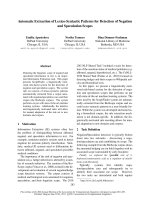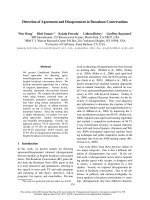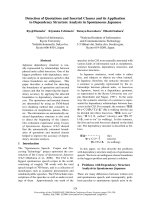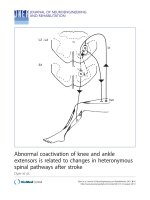Detection of bacteria and enteric viruses from river and estuarine sediment
Bạn đang xem bản rút gọn của tài liệu. Xem và tải ngay bản đầy đủ của tài liệu tại đây (171.77 KB, 10 trang )
Journal of Water and Environment Technology, Vol. 7, No. 4, 2009
Address correspondence to Takayuki Miura, Department of Civil and Environmental Engineering,
Tohoku University, Email:
Received January 9, 2009, Accepted October 25, 2009.
- 307 -
Detection of bacteria and enteric viruses from river and
estuarine sediment
Takayuki MIURA*, Yoshifumi MASAGO*, Yuen-Man CHAN**, Takahiro IMAI*, Tatsuo
OMURA*
* Department of Civil and Environmental Engineering, Tohoku University, 6-6-06, Aoba,
Aramaki, Aoba-ku, Sendai, Miyagi 980-8579, Japan
** Department of Hydraulic & Ocean Engineering, Zhejiang University, 388 Yuhangtang Road,
Hangzhou, Zhejiang Province, 310058, P. R. China
ABSTRACT
River and estuarine sediment is suggested to play an important role in transmission of microbes
in the water environment. However, although effective methods to recover bacteria from
sediment are available, preparation methods for viruses, especially using molecular detection
methods, are still under development. In this study, preparation methods for viruses in sediment
were evaluated by qPCR methods. Thirty-six sediment samples were collected from the Takagi
River and the Matsushima Bay receiving the Takagi River from December 2007 to May 2008
and tested for fecal coliforms, Bacteroides spp., human adenoviruses and Cryptosporidium spp.
As the results, recovery rate of a preparation method for RNA viruses was low (Geometric mean:
3.3%, n=11), while that for DNA viruses was relatively high and stable (Geometric mean: 37%,
n=6). The detection rate was the highest for fecal coliforms (92%, 33/36), followed by
Bacteroides spp. (61%, 22/36). Human adenoviruses and Cryptosporidium spp. were not
detected partly due to the limited sediment volume (0.5 g) applicable to the DNA extraction kit.
Although the high positive rates of fecal coliforms and Bacteroides showed that the preparation
methods for fecal indicator bacteria were applicable for environmental application, it was
recommended that more effective methods for enteric viruses and protozoa be developed for
direct monitoring of pathogens in sediment.
Keywords: Bacteroides, enteric viruses, fecal indicator, sediment.
INTRODUCTION
Sediment has been demonstrated a significant relationship with fecal indicator bacteria
which indicate the presence of pathogens. The concentrations of fecal indicator bacteria
were shown to be much higher in different kinds of sediments than those in the adjacent
water (Craig et al., 2002; Alm et al., 2003; Mimura et al., 2005; Bissett et al., 2006). It
is also reported that fecal coliforms, Escherichia coli and enterococci in the estuarine
sediment were found to survive at least 7 days longer than those in a water column
(Jeng et al., 2005), suggesting that sediment might provide a more stable indicator of
long-term fecal contamination (Craig et al., 2002). When storms, tides, or strong winds
cause sediment resuspension, fecal bacteria survived in sediment would also be
resuspended, resulting high fecal bacteria levels in the water column (Jeng et al., 2005;
Dorner et al., 2006).
Furthermore, recent studies have suggested important roles of sediment in pathogen
contamination. Bacterial, protozoan and viral pathogens have been detected from
sediment: Mycobacterium avium (Whittington et al., 2005), Clostridium botulinum type
E (Perea-Fuentetaja et al., 2006), Cryptosporidium (Searcy et al., 2006), enteroviruses
Journal of Water and Environment Technology, Vol. 7, No. 4, 2009
- 308 -
(Gerba et al., 1977), Hepatitis A Virus (Le Guyader et al., 1994) and Rotavirus (Green
and Lewis, 1999). Survival of Mycobacterium avium in sediment was 12 to 26 weeks
longer than that in the water column (Whittington et al., 2005). These data suggest that
sediment may act as a reservoir of pathogens (Alm et al., 2003; Salvo and Fabiano,
2007). It is suggested that pathogen-sediment interactions be taken into consideration
when predicting the fate of pathogens in the environment (Searcy et al., 2006).
The sample preparation methods which have been used for viruses in sediment consist
of dispersing sediment particles in various buffer solutions, centrifugation to remove the
sediment and purification of the supernatant (Gerba et al., 1977; Bitton et al., 1982;
Wait and Sobsey, 1983; Lewis et al., 1985; Green and Lewis, 1999). Recovery rates of
the preparation methods have been evaluated only using cell-culture based plaque assay
(Gerba et al., 1977; Bitton et al., 1982; Wait and Sobsey, 1983; Lewis et al., 1985),
which ranged from 8 to 50 % for estuarine sediment. Johnson et al. (1984) showed a
negative correlation between virus recovery and ratio of clay in sediment, which
suggested that preparation methods should be evaluated using the sediment collected
from the target area. Although molecular detection methods such as PCR have been
developed and widely used especially for viruses without cell lines (e.g. Norovirus),
sample preparation methods have not been evaluated using molecular methods partly
because some of the preparation methods use beef extract which is known to inhibit
PCR (Wait and Sobsey, 1983; Lewis et al., 1985). Moreover, it is reported that humic
substances which are extracted from soil and sediment inhibit nucleic acids extraction
(Zhou et al., 1996) and Taq DNA polymerase in PCR (Tsai and Olson, 1992; Watson
and Blackwell, 2000). Due to the knowledge mentioned above, it is necessary to
evaluate recovery rates of preparation methods using sediment collected in the target
area by molecular detection methods.
In this study, a field survey was conducted at the Takagi River and the Matsushima Bay
receiving the Takagi River from December 2007 to May 2008. Sediment samples were
collected and tested for fecal coliforms, Bacteroides spp. which is used for microbial
source tracking, human adenoviruses and Cryptosporidium spp. There have been no
reports which explored the three types of microbes, bacteria, virus and protozoa, in the
same field, and there have been no study detecting fecal indicators and pathogens in
sediment in Japan. Recovery rates of preparation methods for both DNA and RNA
viruses in sediment were evaluated by qPCR methods. For DNA virus preparation, a
commercial kit for direct DNA extraction from soil was used. For RNA virus, the
sample preparation method developed by Gerba et al. (1977), which can process large
amount of sediment and which does not use beef extract for elution, was used with
some modification.
MATERIALS AND METHODS
Sample collection
Sediment samples were collected in the Takagi River estuary during the ebb tide
monthly from November 2007 to May 2008. Locations of sample sites are shown in
Figure 1: St.A, St.B and St.C were located in the bay where oyster beds are placed
(Figure 1 & 2); St. D was located at the river mouth; and St.E and St.F were located in
the river downstream. There is a small dam to control the river flow at St.F (Figure 3).
Journal of Water and Environment Technology, Vol. 7, No. 4, 2009
- 309 -
Table 1. Primer and probe sequences for detection of enteroviruses, human adenoviruses,
Bacteroides spp. and Cryptosporidium spp.
Microbes Primer & probe Sequence (5’ - 3’) Annealing
temp.
References
Enteroviruses
(Poliovirus)
Ev1 (Forward) GATTGTCACCATAAGCAGC
60
o
C
Monpoeho
et al., 2003
Ev2 (Reverse) CCCCTGAATGCGGCTAATC
Ev-probe
(TaqMan probe)
(FAM)GGAACCGACTACTTTGGGTG
TCCGT(TAMRA)
Human
adenoviruses
AQ1 (Forward) GCCACGGTGGGGTTTCTAAACTT
55
o
C
Heim
et al., 2003
AQ2 (Reverse) GCCCCAGTGGTCTTACATGCACATC
AP
(TaqMan probe)
(FAM)TGCACCAGACCCGGGCTCA
GGTACTCCGA(TAMRA)
Bacteroides
BacUni_520F CGTTATCCGGATTTATTGGGTTTA
63
o
C
Kildare
et al., 2007
BacUni_690R1 CAATCGGAGTTCTTCGTGATATCTA
BacUni_690R2 AATCGGAGTTCCTCGTGATATCTA
Crypto-
sporidium
Forward CGCTTCTCTAGCCTTTCATGA
60
o
C
Fontaine
et al., 2002
Reverse CTTCACGTGTGTTTGCCAAT
The sample obtained by an Ekman-Birge type bottom sampler covered a square area of
15 by 15 cm, and the top layer of 1 cm was collected. The samples were transported to
the laboratory on ice in sterile containers and processed within a few hours of collection.
Thirty-six samples were collected in total from 6 sample sites for 6 months.
Sample preparation for RNA viruses
Sediment samples were processed following the method by Gerba et al. (1977) with one
modification: a vortex mixer was used for 15 sec instead of a shake table for 10 min to
prevent conformational change in capsid protein caused by high pH of elution buffer
(pH 11.5). The modified procedure is as follows. Five grams of wet sediment were
placed in 50 mL centrifuge tube with 15 mL of 0.25 M glycine-NaOH buffer (pH 11.5)
containing 0.05 M EDTA. The tube was vortexed for 15 sec and centrifuged for 4 min at
Figure 2. Oyster beds at the bay
Figure 3. Dam at the Takagi River (St.F)
1 km0
Takagi River
Wastewater
treatment
plant (WWTP)
Matsushima Bay
Pacific Ocean
Matsushima Town
St.A
St.B
St.C
St.D
St.F
Japan
Tokyo
Miyagi
St.E
Oyster bed
Figure 1. Locations of sample sites
Journal of Water and Environment Technology, Vol. 7, No. 4, 2009
- 310 -
2,500 x g to remove the sediment. The supernatant was collected and pH was adjusted
to 3.5 by addition of 1 M glycine-HCl buffer (pH 2.0). Aluminum chloride (1 M) was
then added to yield a 0.06 M final concentration, and the solution was passed through a
HA membraQHILOWHUȝPSRUHVL]HDQGPPGLDPHWHU0LOOLSRUH7RN\R9LUXV
was eluted from the filter by passage of 10 mL volumes of 0.25 M glycine-NaOH buffer
(pH 11.5) and the eluate was immediately neutralized by addition of 1 M glycine-HCl
buffer (pH 2.0). Viral RNA was extracted using QIAamp RNA mini kit (QIAGEN,
Tokyo), DQG F'1$ ZDV REWDLQHG IURP ȝ/ RXW RI ȝ/ RIWKH H[WUDFWHG 51$ ZLWK
reverse transcription reaction using First Strand cDNA Synthesis Kit for RT-PCR
(Roche, Tokyo).
Sample preparation for Bacteroides spp., Cryptosporidium spp. and Adenovirus
DNA of Bacteroides spp., Cryptosporidium spp. and Adenovirus were extracted directly
from 0.5 g wet sediment samples using ISOIL for Beads Beating (Nippon Gene, Tokyo).
Detection of pathogens and fecal indicators by PCR and qPCR methods
The concentration of (c)DNA of Poliovirus and Adenovirus was determined using
real-time qPCR methods with LightCycler ST300 (Roche, Tokyo). Each 20 ȝ/ 3&5
PL[WXUHFRQWDLQHGȝ/RIF'1$RU'1$ȝ/RI/LJKW&\FOHU7DT0DQ0DVWHU5RFKH
7RN\Rȝ/RIS0SULPHUVDQGȝ/RIS07DT0DQSUREHOLVWHGLQ7DEOH
The PCR condition including a denaturing step at 95
o
C for 10 min, followed by 50
cycles of 95
o
C for 3 sec, annealing temperature specified in Table 1 for 10 sec, and 72
o
C for 30 sec.
For detection of Bacteroides spp. and Cryptosporidium spp., PCR was carried out with
Veriti 96-:HOO7KHUPDO&\FOHU5RFKH7RN\R(DFKȝ/ 3&5PL[WXUe contained 5
ȝ/ RI WKH H[WUDFWHG '1$ ȝ/ RI PDVWHU PL[ 5RFKH 7RN\R ȝ/ RI S0
primers specified in Table 1. The PCR conditions included a denaturing step at 95
o
C for
5 min, followed by 40 cycles of 95
o
C for 1 min, annealing temperature (Table 1) for 1
min, and 72
o
C for 20 sec, followed by a final extension step of 72
o
C for 30 sec. The
PCR products were electrophoresed in 1.5% (w/v) agarose gel stained with ethidium
bromide, and visualized by UV illumination.
Evaluation of recovery rate of preparation method for viruses in sediment
As a surrogate of RNA viruses, Sabin strain of Poliovirus type 1 was spiked into the
sediment taken at St.F (n=11) and recovered following the procedure by Gerba et al.
(1977). Poliovirus belongs to genus Enterovirus and has positive-sense single-stranded
RNA genome surrounded by a non-enveloped, icosahedral capsid of approximately 25
nm diameter. This virus was also used by Gerba et al. (1977) for evaluation of the
method. Recovery rate was evaluated by dividing amount of spiked Poliovirus by
amount of detected Poliovirus from spiked sediment samples.
For DNA viruses, 0.5 g of the sediment samples (n=6) collected at St. F was spiked with
Adenovirus type 41 and was applied to ISOIL for Beads Beating.
Quantitative detection of fecal coliforms from sediment
Fecal coliforms in the sediment samples were recovered following the procedure of
Craig et al. (2002) with some modifications: 5 mL double-distilled water was used
instead of 9 mL 0.1% peptone water; a vortex mixer was used for 15 sec instead of hand
Journal of Water and Environment Technology, Vol. 7, No. 4, 2009
- 311 -
shaking for 1 min. The modified procedure for fecal coliforms isolation is as follows.
One gram of well-mixed wet sediment sample was placed in a 15 mL centifuge tube
with 5 mL double-distilled water. The tube was vortexed for 15 sec and left to settle for
10 min prior to aspirating the supernatant. Five milliliters of the supernatant were
FROOHFWHGGLOXWHGLIQHFHVVDU\DQGSDVVHGWKURXJKD+$PHPEUDQHILOWHUȝPSRUH
size and 47 mm diameter; Millipore, Tokyo) The membrane filter was placed on m-FC
agar (Merck, Tokyo) and incubated at 44.5
o
C for 24 hr. Results were recorded as
CFU/100 g (dry weight) of sediment following previous studies (Craig et al., 2002; Alm
et al., 2003).
Particle size distribution of sediment samples
Particle size distribution of sediment from each sampling point was measured by
Microtrac (9320HRA (X-100); Nikkiso, Tokyo) and composition of sediment was
classified based on the standard of The Japanese Geotechnical Society (JGS 0051-2000)
as follows; clay, < 0.005 mm; silt, 0.005 – 0.075 mm; fine sand, 0.075 – 0.25 mm;
medium sand, 0.25 – 0.85 mm. The samples were collected on May 13th, 2008.
RESULTS AND DISCUSSION
Evaluation of recovery rate of preparation method for viruses in sediment
Figure 4 shows recovery rates of RNA and DNA viruses. Recovery rate (geometric
mean) of Poliovirus (RNA virus) was 3.3 % (geometric standard deviation (GSD) = 0.6,
n = 11) and it was much lower than the recovery rate by Gerba et al. (1977) (50 %).
Figure 5 shows composition of particle size of sediment from each sampling point.
Gerba et al. (1977) mentioned that their sediment was largely composed of organic mud
and sand, while the sediment sample taken at St.F was mainly consisted of silt (67 %)
and clay (13 %). As mentioned by Johnson et al. (1984), the difference in the recovery
rates may be because of the difference of particle size distribution of the sediment,
especially composition of silt and clay. The low recovery rate was also because of the
inhibition of nucleic acids extraction and PCR by humic substances extracted from
sediment by high pH as Tsai and Olson (1992), Zhou et al. (1996) and Watson and
Blackwell (2000) reported. The color of supernatant after vortex mixing and
centrifugation was brown and that of the concentrate after membrane filtration was
yellow, both of which indicates the presence of humic substances. Therefore, the
method by Gerba et al. (1977) was not sensitive enough for the sediment in the Takagi
River and it is suggested that more reliable and sensitive preparation method for RNA
viruses in sediment with high proportion of silt and clay and with presence of humic
substances should be developed for environmental monitoring. Based on this result,
naturally occurring RNA viruses were excluded from the field monitoring.
Recovery rate (geometric mean) of Adenovirus type 41 (DNA virus) using ISOIL for
Beads Beating was 37 % (GSD = 0.03, n = 6) and it was comparable with reported virus
recoveries, such as 50 % reported by Gerba et al. (1977), 8 % to 22 % by Bitton et al.
(1982), 31 % by Wait and Sobsey (1983), and 18 ± 20 (% ± SD) by Lewis et al. (1985),
although there are differences in viruses, sediment, extraction and detection methods.
The relatively high and stable recovery may be because of efficient extraction of viral
DNA with removing humic substances.









